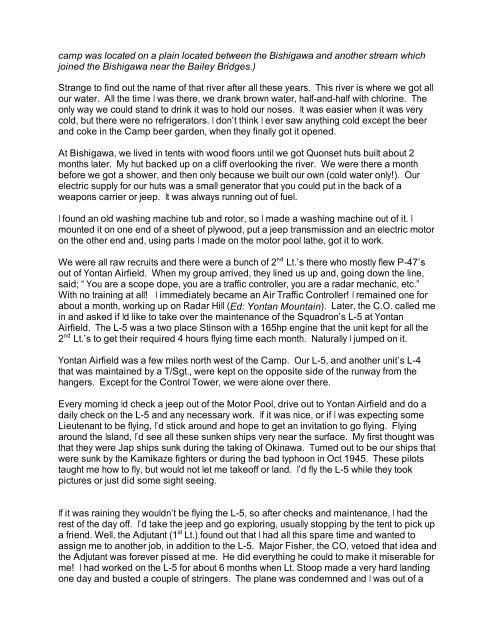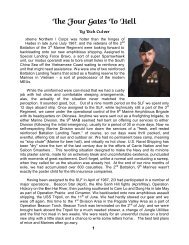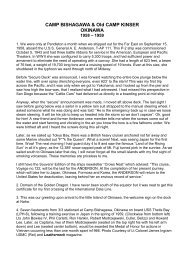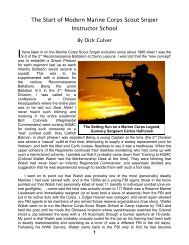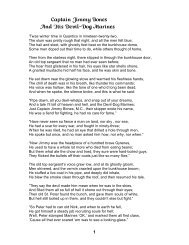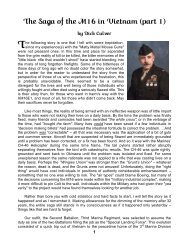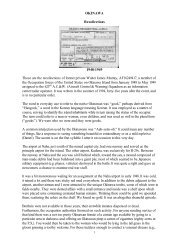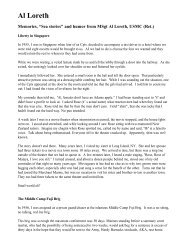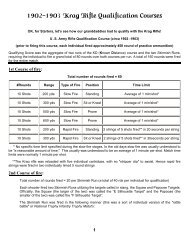Bill Choate at Bishagawa in 1946 - Rohrer, Bob Rohrer
Bill Choate at Bishagawa in 1946 - Rohrer, Bob Rohrer
Bill Choate at Bishagawa in 1946 - Rohrer, Bob Rohrer
You also want an ePaper? Increase the reach of your titles
YUMPU automatically turns print PDFs into web optimized ePapers that Google loves.
camp was loc<strong>at</strong>ed on a pla<strong>in</strong> loc<strong>at</strong>ed between the Bishigawa and another stream which<br />
jo<strong>in</strong>ed the Bishigawa near the Bailey Bridges.)<br />
Strange to f<strong>in</strong>d out the name of th<strong>at</strong> river after all these years. This river is where we got all<br />
our w<strong>at</strong>er. All the time I was there, we drank brown w<strong>at</strong>er, half-and-half with chlor<strong>in</strong>e. The<br />
only way we could stand to dr<strong>in</strong>k it was to hold our noses. It was easier when it was very<br />
cold, but there were no refriger<strong>at</strong>ors. I don’t th<strong>in</strong>k I ever saw anyth<strong>in</strong>g cold except the beer<br />
and coke <strong>in</strong> the Camp beer garden, when they f<strong>in</strong>ally got it opened.<br />
At Bishigawa, we lived <strong>in</strong> tents with wood floors until we got Quonset huts built about 2<br />
months l<strong>at</strong>er. My hut backed up on a cliff overlook<strong>in</strong>g the river. We were there a month<br />
before we got a shower, and then only because we built our own (cold w<strong>at</strong>er only!). Our<br />
electric supply for our huts was a small gener<strong>at</strong>or th<strong>at</strong> you could put <strong>in</strong> the back of a<br />
weapons carrier or jeep. It was always runn<strong>in</strong>g out of fuel.<br />
I found an old wash<strong>in</strong>g mach<strong>in</strong>e tub and rotor, so I made a wash<strong>in</strong>g mach<strong>in</strong>e out of it. I<br />
mounted it on one end of a sheet of plywood, put a jeep transmission and an electric motor<br />
on the other end and, us<strong>in</strong>g parts I made on the motor pool l<strong>at</strong>he, got it to work.<br />
We were all raw recruits and there were a bunch of 2 nd Lt.’s there who mostly flew P-47’s<br />
out of Yontan Airfield. When my group arrived, they l<strong>in</strong>ed us up and, go<strong>in</strong>g down the l<strong>in</strong>e,<br />
said; “You are a scope dope, you are a traffic controller, you are a radar mechanic, etc.”<br />
With no tra<strong>in</strong><strong>in</strong>g <strong>at</strong> all! I immedi<strong>at</strong>ely became an Air Traffic Controller! I rema<strong>in</strong>ed one for<br />
about a month, work<strong>in</strong>g up on Radar Hill (Ed: Yontan Mounta<strong>in</strong>). L<strong>at</strong>er, the C.O. called me<br />
<strong>in</strong> and asked if Id like to take over the ma<strong>in</strong>tenance of the Squadron’s L-5 <strong>at</strong> Yontan<br />
Airfield. The L-5 was a two place St<strong>in</strong>son with a 165hp eng<strong>in</strong>e th<strong>at</strong> the unit kept for all the<br />
2 nd Lt.’s to get their required 4 hours fly<strong>in</strong>g time each month. N<strong>at</strong>urally I jumped on it.<br />
Yontan Airfield was a few miles north west of the Camp. Our L-5, and another unit’s L-4<br />
th<strong>at</strong> was ma<strong>in</strong>ta<strong>in</strong>ed by a T/Sgt., were kept on the opposite side of the runway from the<br />
hangers. Except for the Control Tower, we were alone over there.<br />
Every morn<strong>in</strong>g Id check a jeep out of the Motor Pool, drive out to Yontan Airfield and do a<br />
daily check on the L-5 and any necessary work. If it was nice, or if I was expect<strong>in</strong>g some<br />
Lieutenant to be fly<strong>in</strong>g, I’d stick around and hope to get an <strong>in</strong>vit<strong>at</strong>ion to go fly<strong>in</strong>g. Fly<strong>in</strong>g<br />
around the Island, I’d see all these sunken ships very near the surface. My first thought was<br />
th<strong>at</strong> they were Jap ships sunk dur<strong>in</strong>g the tak<strong>in</strong>g of Ok<strong>in</strong>awa. Turned out to be our ships th<strong>at</strong><br />
were sunk by the Kamikaze fighters or dur<strong>in</strong>g the bad typhoon <strong>in</strong> Oct 1945. These pilots<br />
taught me how to fly, but would not let me takeoff or land. I’d fly the L-5 while they took<br />
pictures or just did some sight see<strong>in</strong>g.<br />
If it was ra<strong>in</strong><strong>in</strong>g they wouldn’t be fly<strong>in</strong>g the L-5, so after checks and ma<strong>in</strong>tenance, I had the<br />
rest of the day off. I’d take the jeep and go explor<strong>in</strong>g, usually stopp<strong>in</strong>g by the tent to pick up<br />
a friend. Well, the Adjutant (1 st Lt.) found out th<strong>at</strong> I had all this spare time and wanted to<br />
assign me to another job, <strong>in</strong> addition to the L-5. Major Fisher, the CO, vetoed th<strong>at</strong> idea and<br />
the Adjutant was forever pissed <strong>at</strong> me. He did everyth<strong>in</strong>g he could to make it miserable for<br />
me! I had worked on the L-5 for about 6 months when Lt. Stoop made a very hard land<strong>in</strong>g<br />
one day and busted a couple of str<strong>in</strong>gers. The plane was condemned and I was out of a


